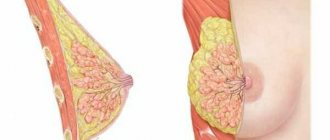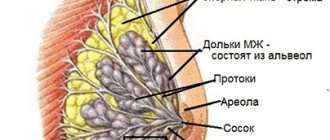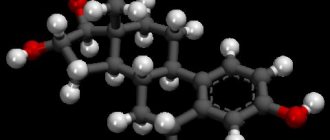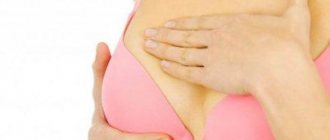What is a breast cyst?
A cyst is a pathology of cavity formation, characterized by the formation in the ducts of a formation resembling capsules with liquid contents. Can be single or multiple. Cysts vary in structure, shape and size.
A cyst can appear in a woman at any age, but for each of them the internal structure of the formation and the course of the disease proceed differently.
Symptoms of a breast cyst
- A small cyst in the breast rarely causes discomfort to a woman. As a rule, it is not palpable and is detected accidentally during mammography.
- Medium-sized cystic formations have more pronounced symptoms. Usually, on the eve of menstruation, pain appears and breast swelling becomes noticeable.
- Large cysts are manifested by constant nagging pain, a burning sensation in the chest, and uneven tissue densification.
- Very large cysts (more than 4-6 mm) lead to deformation of the mammary glands, cause redness of the skin over the formation, and in some cases, cyanosis. Liquid (brown, bloody or greenish) is released from the nipples.
List of sources
- Burdina L.M. “Treatment of diseases of the mammary glands and concomitant disorders of menstrual function with mastodinone” // Attending physician. - 1999. - No. 8. - P. 13-25.
- Guseinov A.Z., Istomin D.A. Focal formations of the mammary gland: nosological forms, diagnosis and treatment. Guide for doctors. – Tula: Tula State University Publishing House, 2011, 142 p.
- Rozhkova N.I., Burdina I.I., Prokopenko S.P. “Prospects for mammology in the new century” // Russian Journal of Oncology. - 2001. - No. 3. - P 55-56.
How to treat a breast cyst?
The first thing you can and should do when you suspect any breast disease or any painful and unpleasant symptoms is to make an appointment with a specialist, in this case a mammologist. Only a doctor will be able to conduct an examination, select an adequate treatment for the disease and prescribe medications for the treatment of breast cysts. You may need additional consultation with other doctors - a gynecologist and an endocrinologist.
Modern methods of treatment
- Puncture - taking fluid from the “capsule” of the formation and injecting a solution to destroy the remaining shell. This method is suitable if there is only one cyst in the gland. In case of multiple formations, a full-fledged operation is usually chosen, and the extracted tissue is subjected to histological analysis.
- Drainage - a cavity is pierced with a thin needle, the liquid is aspirated, and the remaining space is filled with either air or ozone. Afterwards, observation by a mammologist is required.
- Aspiration - a cannula is inserted into the cavity of the “capsule”, with the help of which liquid is pumped out of the cavity, and then they look for the presence of blood: if there is none, surgery is not needed, and if there is, additional tests are performed.
But in general, surgical manipulations in general are far from always achieved, since most often conservative treatment is sufficient - with the help of medications for the cyst. These include:
- hormone replacement therapy – course normalization of hormones in the body;
- special non-hormonal drugs;
- sedative therapy, since sex hormones control the formation of cysts and the appearance of diseases such as fibrocystic mastopathy, sensitive to stress and tension.
Diagnostics
To diagnose cystic formations, the following methods are used:
- inspection;
- palpation;
- Ultrasound;
- mammography;
- ductography (if intraductal papilloma is suspected);
- puncture (usually a fine-needle biopsy);
- blood test for tumor markers (if there are altered cells in the punctate).
In this paragraph, we will answer one of the frequently asked questions from readers - what is blood flow AK and how does it differ from a regular one? Normally, ultrasound with Doppler ultrasound does not detect blood flow in cystic formations.
If the description states “with blood flow along the periphery,” most likely, the cystic formation is “located” next to the vessel that feeds it. Don't worry ahead of time, it's not precancer yet. A biopsy is needed for an accurate diagnosis. Only in the presence of altered cells in the biopsy can one speak of the onset of malignancy.
Sometimes increased blood flow near the AC during ultrasound is noticeable due to inflammation. If the neoplasm grows into vessels and the doctor determines the presence of blood flow, it is no longer a cyst, but cancer.
Drug treatment of cysts
A properly selected course of treatment helps to cope with the problem without surgical intervention. What to drink is prescribed by an oncologist or mammologist. The drugs differ in nature, active ingredient and dosage. Therefore, only a specialist can choose treatment depending on the characteristics of the tumor.
In addition to the main therapeutic drug, doctors recommend taking drugs to normalize metabolic processes and immunocomplex medications. In addition, iodine preparations may be prescribed to reduce the proliferative activity of tissues and normalize the functioning of the thyroid gland.
Drug treatment is indicated for small cysts that manifest moderate pain. Before prescribing drugs, a diagnosis is carried out with a biopsy to exclude oncology.
Let's consider popular drugs for the treatment of breast cysts:
- "Mastodinon" - inhibits the production of the hormone prolactin, which causes cysts to grow. The drug is completely safe and consists of herbal ingredients. Available in drops or tablets.
- "Indinol" - also consists of a plant component, is effective in the early stages of the development of pathology. The course of treatment can be twice as long as its predecessor.
- "Klamin" - the remedy will not help quickly get rid of a breast cyst, but will slow down its growth. It contains active substances that improve metabolism and stop the degeneration into cancer.
- “Fitolon” – has a beneficial effect on the immune system, destroys microbes, and relieves inflammation. The dosage and course of treatment are selected by the doctor.
- “Mamoklam” is a medicine for cysts that eliminates swelling and inflammatory processes in the mammary glands and promotes the resorption of various lumps. The product contains iodine and auxiliary substances. The dosage is selected by the doctor.
For complete treatment, vitamins and sedatives are prescribed. If suppuration appears, the doctor may prescribe antibiotics.
Classification
According to the size of the formations, there are two types of breast cysts:
- Microcysts are small cysts that are not detected by palpation due to their size, but are detected by ultrasound or mammography.
- Macrocysts are detected during palpation, their size is usually 2.5-5 cm. If the formations are large, they can put pressure on the nerve endings, as a result of which the woman feels discomfort and pain.
Two types of cysts are also defined according to their structure:
- Simple - such tumors consist of a single formation. It may contain a fibrous component.
- Complex - a multi-chamber cyst, which consists of simple formations fused with each other. Fibrous tissue may grow inside. Atypical cysts belong to this type.
There is also a classification, according to which several varieties of such formations are distinguished, differing in certain features.
- Atypical breast cyst - such a formation grows inside the cavity in the dilated duct. An atypical tumor is prone to recurrence and inflammation. Benign and malignant papillomomatous formations can develop in the cavity.
- Fibrous - cavities are formed due to the proliferation of fibrous tissue and accumulate fluid. Later the fluid comes out through the nipples. Such formations are a prerequisite for the development of oncological processes.
- A solitary cyst of the mammary gland is a benign formation that forms in one gland and looks like a dense capsule. A solitary cyst may contain fluid of different colors.
- A ductal cyst of the mammary gland is a benign formation that is usually diagnosed in women after 50 years of age. Ductal tumor is a precancerous condition.
- Fatty - benign formations that appear due to blockage of the sebaceous glands in the skin. As a rule, it appears during pregnancy or breastfeeding.
- Multi-chamber - small formations that after some time combine into one cyst.
- Cysts against the background of diffuse mastopathy - with this diagnosis, the structure of the breast tissue changes, the connective tissue structures grow unevenly, as a result of which nodules and cords form. As a result, the structure of the breast lobules and ducts is disrupted, resulting in the formation of small cysts. Sometimes the disease develops into nodular mastopathy.
Polycystic disease stands out separately - multiple cysts of different sizes. After some time, multiple cysts unite into multi-chamber conglomerates.
Non-drug treatment of cysts
Physiotherapy
A breast cyst can be treated with physical therapy, but such a program should be approached with great caution. The main condition is the absence of malignant neoplasms, pain and swelling.
For treatment, two methods can be used:
- Electrophoresis - used in low doses and under the strict supervision of the attending physician. During the procedures, medications are applied to the skin, which, under the influence of weak electrical impulses, are absorbed into the parenchyma of the gland. In 10-15 sessions, swelling and inflammation are relieved, immunity is increased, and with full conservative therapy, cysts resolve.
- Radon baths - before using these procedures, a woman should definitely visit a doctor; if there is a risk of tumor formation, treatment is excluded. In other cases, such physiotherapy will be beneficial - it will relieve pastiness, activate blood flow, and create conditions for the resorption of compactions.
Other physical procedures are strictly prohibited. If necessary, they can be replaced with therapeutic exercises.
Exercise therapy
If the disease is in remission, physical therapy can be included in the program. Exercises should be light and not overload a weakened body.
There are two types of exercises you can do at home:
- Wall push-ups are done measuredly and accurately, with a straight back and straight legs. It is optimal to do 2-3 approaches 5-8 times.
- Raising arms fastened into a lock - perform with moderate effort for 1-3 minutes.
These exercises are aimed at training the pectoral muscles and activating blood circulation.
Folk remedies
Herbal infusions are highly effective. They are used in complex therapy.
Efficacy of herbs
The basis of fibrocystic mastopathy is a single benign lump. Pathology involves fluid accumulation. In the early stages, this type of disease can be treated with folk remedies, which are used in combination with medications.
Recipes
In folk medicine, there are many methods for treating mastopathy using herbs. All of them have a high degree of efficiency.
Among the most common folk remedies are:
- Burdock compress . The washed sheet is applied to the affected area of the chest overnight. The procedure is repeated for 3-5 nights, after which a break is taken for two weeks.
- A mixture of celandine juice and vegetable oil in a 1:1 ratio has an anti-cancer effect. It is rubbed into the problem area of the breast for a month, then a week break is taken.
- Woodlice eliminates pain and swelling and has a sedative effect. A handful of dry grass is poured with boiling water, cooled and applied to the chest.
- Cabbage leaf . A compress based on it is applied every day for several hours for a month.
- Oak bark . The decoction is prepared from 2 tbsp. l. powdered product. He pours a glass of water. The product is boiled until half the liquid evaporates. The chest is wrapped in a cotton wool disc soaked in infusion. The cotton pad is covered with cellophane.
- Beeswax . The melted substance is used to form cakes, which are fixed on the chest overnight. The duration of the procedure is 12 days.
- Rose hip . Mammologists recommend using an infusion of rose hips, hawthorn, string leaves, motherwort, St. John's wort, plantain, mint and valerian root. Two tbsp. l. pour 500 ml of boiling water into the mixture. The container is tightly closed and filtered after 2 hours. Half an hour before meals you should drink 50 g of infusion. The duration of therapy is 2 months.
- Burdock . To prepare the decoction 2 tbsp. l. crushed plant root is poured with 2 tbsp. l. cold water. The mixture is infused and boiled, then filtered. Taken three times a day for 24 hours.
- Sage . An infusion from the plant is taken. It is drunk three times a day. Crushed leaves and inflorescences are poured into a glass of boiling water. The mixture is brought to a boil and infused overnight.
- Celandine . A poisonous plant with a high degree of effectiveness. 1 tbsp is poured into a thermos. l. leaves, stems and inflorescences. They are poured with a glass of boiling water. A third glass is taken an hour before meals for a month. The break between courses is a week.
- Golden mustache . The remedy is obtained by mixing 2 tbsp. l. plants with a glass of vodka. Infuses for 2 weeks. Take 3 tsp. once a day on an empty stomach. The course of treatment is 6 months. Every 3 weeks there is a one-week break.
- Wormwood . Mix 1 tbsp. l. wormwood, nettle, knotweed, valerian root. The mixture is poured with 500 ml of water, brought to a boil and left for 20 minutes in a steam bath. Then the broth is cooled, filtered, divided into three parts and drunk over the next day. The pain will disappear on the same day. The swelling will disappear within a week.
Surgical removal of cysts
When cysts grow and the pills are no longer effective, surgical intervention becomes necessary. There are several methods for removing tumors:
- Puncture - performed in cases where the cyst consists of vesicles connected to each other by connective tissue and filled with liquid inside. During the manipulation, the cyst is punctured and all the secretion is removed from it.
- Laser removal is a modern and safe, but not a cheap method. Excision of a cyst with a laser is carried out quickly and painlessly, without scarring. LED exposure destroys only atypical cells. Over the next two months, they are completely replaced by healthy glandular cells.
- Surgical intervention is necessary for large cysts or high-density neoplasms. The operation is carried out with high precision; upon completion, the tissue at the incision site is stitched together in layers. A sick leave after surgery is issued by the doctor for the entire recovery period.
Forecast
Doctors give a favorable prognosis for therapy if it is started on time. Treatment allows you to avoid relapses and transformation of the tumor into malignant. If the cyst is not treated, its development progresses and can lead to negative consequences.
In particularly dangerous situations, surgery is performed. Surgery eliminates the tumor. After this, restorative treatment is carried out. It is necessary to treat the pathology until the breast tissue is completely restored. Relapses of the disease after surgery are extremely rare. Timely antibiotic therapy contributes to a woman’s rapid recovery.
Prevention of cyst formation
Since the main cause of the disease is hormonal imbalance in the body, the main law of its prevention is to restore and maintain a healthy balance in the body.
First of all, it is eating balanced natural foods that are low in fat and high in fiber. It is very useful to adhere to the principles of separate nutrition. You should drink enough water daily (at least 4 glasses) and reduce your intake of caffeine-containing liquids and foods as much as possible.
Maintain normal body weight and pay attention to physical activity. It has been scientifically proven that physical exercise helps normalize the hormonal levels of women.
It is recommended to conduct a breast self-examination at least once every few months and undergo a professional medical examination by a mammologist once a year.
Diet
Diet for breast mastopathy
- Efficacy: no data
- Terms: 3-12 months
- Cost of products: 1500-1600 rubles. in Week
Women who have a breast cyst are advised to eat healthy and natural foods. It is better to eat in small portions and often. It is important to have breakfast and not eat heavy food at night. You should also follow some recommendations:
- Minimize the amount of caffeine in your diet - consume less coffee, chocolate, and strong tea.
- Reduce the amount of salt in your diet. Reducing sodium intake reduces symptoms.
- Avoid smoked foods, fast food, and fatty foods. Minimize fried foods and confectionery products.
- The daily diet should include fresh vegetables and fruits, dairy products, vegetable oils, meat, fish, and cereals.











